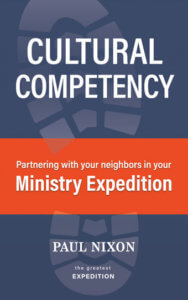It’s easy to lose sight of the ways God is alive and at work in our communities without intentional efforts to know and understand our neighbors. Paul Nixon describes three strategies for reconnecting with the pulse of your community.
Even if we have lived in the same neighborhood for decades, we may be surprised to discover more closely the experiences and values of the neighbors we don’t hang out with: the younger set, the newcomers, the people who speak a different language. Preconceived notions and stereotypes can really throw us off. Things that were true yesterday, and may not be true today, can trip us up. We may need to unlearn some ideas that are incorrect and that are blocking us from engaging with these neighbors constructively.
Prayer walks
One great exercise in getting started listening and unlearning is a prayer walk. We meet at the church or at a coffee shop and go out into the neighborhood to walk around for an hour with the prayer on your heart, “God, please show me something I need to see in order to better understand my neighbors.” We deliberately suspend all assumptions and just look with curiosity. The family in the first house you pass has tall weeds in their yard. Your easy assumption could be, “These people don’t care enough to mow their grass.” A better stance is to say, “I wonder why the grass is so high here.” We might be surprised by the amount of care in that home. It might be that they can’t afford a lawn mower or that they work multiple shifts to put food on the table and have no energy left for yard work. Or you might say, “In the lives of this family, I bet there are things a lot more important than these weeds. I wonder what they are.”
Love letters
An alternative to a prayer walk is to sit on a park bench and write love letters to people. We just people watch until someone catches our eye, and then write them a letter (which they will never read) sharing what we wish we could say to them related to the Christian Good News if we knew them. This exercise forces us to look more closely, to really see people, and to nurture compassion for them.
One-on-one conversations
Best of all are 1:1 conversations, where we invite people that seem interesting (and have a pulse) to give us half an hour and to tell us about themselves. The 1:1 meeting is a precious tool from the community-organizing world. This kind of encounter is not to advertise our ministry but to discover what they can teach us, to discover what energizes them. There is no hard agenda to the conversation, no clipboard with set questions. We allow the conversation to flow where it flows. When people tell us something interesting, we stop and ask why. A good goal is to keep it to where the other person gets 70 percent of the airtime. This is about powerful, focused listening. A 30-minute conversation might go like this in places:
- “Our church is really in a listening mode, trying to pay attention to what’s going on in people’s lives, so that we can create programs and organize ministry that is relevant and helpful. I would love to pick your brain, hear a little of your story and your angle on this community. Would you have a half an hour to chat?”
- “So, what brought you to live here? What do you think? Why did you choose here, or did here choose you? What’s really good about living here? What’s hard about life here? (If the person has children) Where do your kids go to school? You like the school?” Etc.
- “Tell me what I might be missing when I look around in this neighborhood. Where do you think that my church or I need to pay close attention?”
- “What kind of work do you do? Tell me about something you love to do, or that you are good at. How did you get good at it? Did someone teach you to love this thing, or mentor you at it? Are there other people around here who share your passion? Do you get together with them? What happens? Or if you were to get together with them, what might happen?”
- “What experiences or special people helped make you who you are? (Let’s say the person’s name is Malcolm.) How did you get to be this Malcolm?”
Toward the end of the half hour, we can share just a bit about whatever our church is up to in the community or about how we got involved with it. (Let’s keep this part very brief unless they riddle you with questions.) After 30 minutes, we wrap it up. Forty minutes is the absolute stop; at this point we apologize that we have to run. We thank them for their time.
We probably did not make it through half the things we could have explored in such a short conversation. So, we can decide on the spot if we would like to spend another half hour with this person in the near future. If we would like to visit again, we should ask them if that would be okay. We tell them honestly if and how their story has been helpful or encouraging for us. And whenever possible, we ask: “Is there someone else in our community that I should talk to? You’ve heard a bit about what we are up to. Is there someone who comes to mind who might have insight we need to hear?”
Showing up to what God is doing
One good reason for prayer-walking and 1:1 conversations is to help us discover clues as to what God is up to already all around us so that we can build upon the foundation of whatever good is currently unfolding. God is alive and at work in every neighborhood. Our challenge is to show up to what God is doing.
 Adapted from Cultural Competency: Partnering with Your Neighbors in Your Ministry Expedition (Market Square Books, 2021) by Paul Nixon. Used by permission. The book is available at Market Square Books, Cokesbury, and Amazon.
Adapted from Cultural Competency: Partnering with Your Neighbors in Your Ministry Expedition (Market Square Books, 2021) by Paul Nixon. Used by permission. The book is available at Market Square Books, Cokesbury, and Amazon.
Related Resources
- How One-to-One Conversations Reintroduced a Church to its Neighbors by Travis Norvell
- A Spiritual Approach to Community Assessment by Luke Edwards
- 4 Shifts for More Authentic Community Engagement by Dan Pezet







